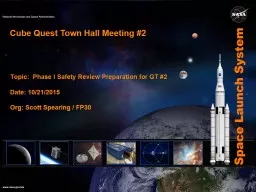PPT-Topic : Phase I Safety Review Preparation for GT #2
Author : tatiana-dople | Published Date : 2018-10-26
Date 10212015 Org Scott Spearing FP30 Cube Quest Town Hall Meeting 2 Agenda Safety Ground Rules Safety Review Process Overview Safety Data Package Development
Presentation Embed Code
Download Presentation
Download Presentation The PPT/PDF document "Topic : Phase I Safety Review Prepara..." is the property of its rightful owner. Permission is granted to download and print the materials on this website for personal, non-commercial use only, and to display it on your personal computer provided you do not modify the materials and that you retain all copyright notices contained in the materials. By downloading content from our website, you accept the terms of this agreement.
Topic : Phase I Safety Review Preparation for GT #2: Transcript
Download Rules Of Document
"Topic : Phase I Safety Review Preparation for GT #2"The content belongs to its owner. You may download and print it for personal use, without modification, and keep all copyright notices. By downloading, you agree to these terms.
Related Documents



![[EPUB] - Princeton Review MCAT Prep, 2021-2022: 4 Practice Tests + Complete Content Coverage](https://thumbs.docslides.com/901857/epub-princeton-review-mcat-prep-2021-2022-4-practice-tests-complete-content-coverage-graduate-school-test-preparation.jpg)
![[EBOOK] - Princeton Review ACT Premium Prep, 2021: 8 Practice Tests + Content Review](https://thumbs.docslides.com/902249/ebook-princeton-review-act-premium-prep-2021-8-practice-tests-content-review-strategies-2021-college-test-preparation.jpg)
![[DOWNLOAD] - Princeton Review ACT Prep, 2021: 6 Practice Tests + Content Review + Strategies](https://thumbs.docslides.com/902257/download-princeton-review-act-prep-2021-6-practice-tests-content-review-strategies-2021-college-test-preparation.jpg)
![[EPUB] - PPI FE Review Manual: Rapid Preparation for the Fundamentals of Engineering](https://thumbs.docslides.com/902673/epub-ppi-fe-review-manual-rapid-preparation-for-the-fundamentals-of-engineering-exam-3rd-edition-a-comprehensive-preparatio.jpg)
![[READ] - Princeton Review ACT Premium Prep, 2020: 8 Practice Tests + Content Review +](https://thumbs.docslides.com/902764/read-princeton-review-act-premium-prep-2020-8-practice-tests-content-review-strategies-college-test-preparation.jpg)
![[EBOOK] - Princeton Review PSAT/NMSQT Prep, 2020: Practice Tests + Review & Techniques](https://thumbs.docslides.com/903064/ebook-princeton-review-psat-nmsqt-prep-2020-practice-tests-review-techniques-online-tools-2020-college-test-preparation.jpg)
![[EBOOK] - ASP Safety Fundamentals Exam Secrets Study Guide: ASP Test Review for the Associate](https://thumbs.docslides.com/903275/ebook-asp-safety-fundamentals-exam-secrets-study-guide-asp-test-review-for-the-associate-safety-professional-exam.jpg)
![[EPUB] - CPCE Practice Questions: CPCE Practice Tests & Exam Review for the Counselor](https://thumbs.docslides.com/903588/epub-cpce-practice-questions-cpce-practice-tests-exam-review-for-the-counselor-preparation-comprehensive-examination.jpg)
![[READ] - Princeton Review ACT Prep, 2021: 6 Practice Tests + Content Review + Strategies](https://thumbs.docslides.com/905271/read-princeton-review-act-prep-2021-6-practice-tests-content-review-strategies-2021-college-test-preparation.jpg)
![[DOWNLOAD] - ASAP Biology: A Quick-Review Study Guide for the AP Exam (College Test Preparation)](https://thumbs.docslides.com/905638/download-asap-biology-a-quick-review-study-guide-for-the-ap-exam-college-test-preparation.jpg)
![[READ] - NCLEX-RN Content Review Guide: Preparation for the NCLEX-RN Examination](https://thumbs.docslides.com/905686/read-nclex-rn-content-review-guide-preparation-for-the-nclex-rn-examination.jpg)
![[READ] - Princeton Review SAT Prep, 2021: 5 Practice Tests + Review & Techniques + Online](https://thumbs.docslides.com/906338/read-princeton-review-sat-prep-2021-5-practice-tests-review-techniques-online-tools-2021-college-test-preparation.jpg)